
The Rocky Mountain locust is an extinct species of grasshopper that ranged through the western half of the United States and some western portions of Canada with large numbers seen until the end of the 19th century. Sightings often placed their swarms in numbers far larger than any other locust species, with one famous sighting in 1875 estimated at 198,000 square miles (510,000 km2) in size, weighing 27.5 million tons and consisting of some 12.5 trillion insects, the greatest concentration of animals ever speculatively guessed, according to Guinness World Records.

Acrididae, commonly called short-horned grasshoppers, are the predominant family of grasshoppers, comprising some 10,000 of the 11,000 species of the entire suborder Caelifera. The Acrididae are best known because all locusts are of the Acrididae. The subfamily Oedipodinae is sometimes classified as a distinct family Oedipodidae in the superfamily Acridoidea. Acrididae grasshoppers are characterized by relatively short and stout antennae, and tympana on the side of the first abdominal segment.
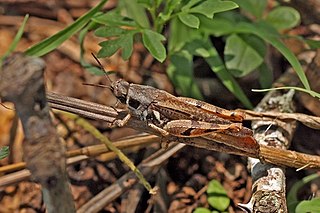
The subfamily Catantopinae is a group of insects classified under family Acrididae. Genera such as Macrotona may sometimes called "spur-throated grasshoppers", but that name is also used for grasshoppers from other subfamilies, including the genus Melanoplus from the Melanoplinae.
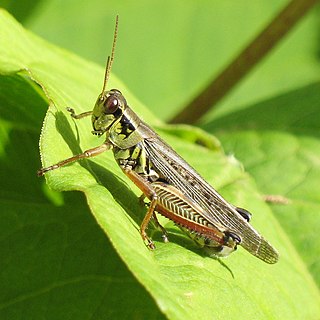
Melanoplus is a large genus of grasshoppers. They are the typical large grasshoppers in North America. A common name is spur-throat grasshoppers, but this more typically refers to members of the related subfamily Catantopinae.
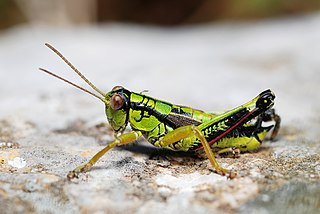
Miramella is a small genus of short-horned grasshoppers in the subfamily Melanoplinae. They are found in Europe and eastern Asia. As of January 2019, Orthoptera Species File lists seven species in three subgenera. The genus was first named in 1932. Miramella is the type genus of the subtribe Miramellina.

Sigaus childi is an endangered protected species of grasshopper known only from the Alexandra district of the South Island of New Zealand. It is one of just two species of grasshopper listed for protection under the New Zealand Wildlife Act 1953. It is currently classified as "At Risk, Naturally Uncommon" by the Department of Conservation. The genus Sigaus is endemic to New Zealand.

Brachaspis robustus is a nationally endangered species of grasshopper endemic to the Mackenzie Basin of the South Island of New Zealand. The genus Brachaspis is endemic to the South Island of New Zealand. Although a grasshopper, it is a poor jumper, relying on camouflage to hide from predators. It is threatened by introduced mammals such as stoats, hedgehogs, and rats.
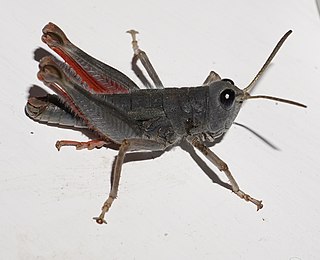
Sigaus villosus is New Zealand's largest grasshopper. It is only found in the central mountains of the South Island. The genus Sigaus is endemic to the New Zealand. Like all of New Zealand sub-alpine and alpine grasshoppers S. villosus has a 2 or 3 years life cycle. The eggs must ‘overwinter’ before they will hatch. Hoppers are found throughout the year and adult grasshoppers can be found throughout the New Zealand summer between December and April. Adult S. villosus do not overwinter.

Sigaus of grasshoppers in the tribe Catantopini that isendemic to New Zealand, and all but one species is endemic to the South Island: Sigaus piliferus is the only North Island representative and is the type species. There are eight species in the genus; all are flightless, and many are coloured for camouflage against rocky ground. Sigaus minutus and S. childi are threatened with extinction.

Sigaus australis is the most common alpine grasshopper found in New Zealand. It can be found in the southern half of the South Island above the tree line. Sigaus australis was described in 1897 by Frederick Hutton. Like all of New Zealand sub-alpine and alpine grasshoppers S. australis has a 2 or 3 years life cycle. Individuals can survive the cold by freezing solid at any life stage, at any time of the year. Sigaus australis adults are relatively large grasshoppers. The genus Sigaus is endemic to New Zealand.

Phaulacridium marginale is a small species of short-horned grasshopper in the family Acrididae. It is endemic to New Zealand where it is found in low elevation open habitat throughout North Island, South Island, Stewart Island and on many smaller islands.

Eyprepocnemis plorans, the lamenting grasshopper, is a species of insect in the family Acrididae. It is the type species of the genus Eyprepocnemis, and is found in Africa, parts of the Middle East, and southern Europe. It typically inhabits wetlands and other moist habitats.
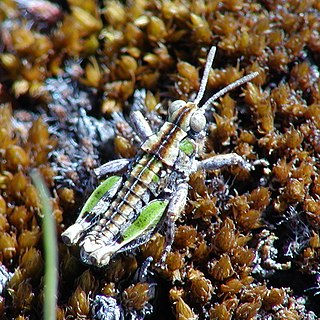
Sigaus minutus is a species of short-horned grasshopper in the family Acrididae. It is one of the smallest and rarest species of grasshopper in New Zealand, found only in the Mackenzie district of South Island. There are nine species within the genus Sigaus described by Bigelow (1967), all endemic to New Zealand. The population status of Sigaus minutus is declining according to threat assessments made by orthopteran experts in 2010.
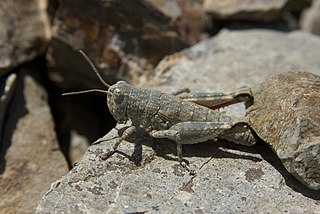
Brachaspis nivalis, is an alpine short-horned grasshopper, endemic to the South Island of New Zealand. Brachaspis nivalis is brachypterous and flightless, therefore they travel by hopping. They bask during the day so need open habitat.
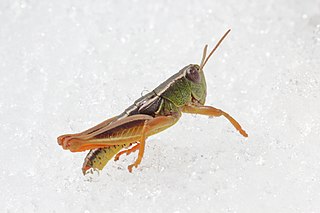
Paprides is a genus of short-horned grasshoppers in the family Acrididae. There are at least two described species in Paprides, found in New Zealand.
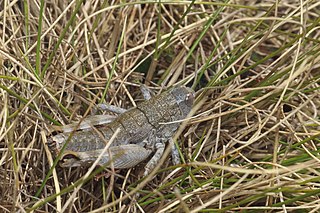
The Green Rock-hopper grasshopper, Brachaspis collinus is an alpine species of short-horned grasshopper in the family Acrididae. It is found in New Zealand in the mountains of northern South Island, above the tree line and as high as 2000 m asl. In New Zealand alpine grasshoppers can freeze solid at any time of the year and are alive when they thaw out when temperatures rise.

Sigaus campestris is a species of short-horned grasshopper in the family Acrididae. it is found in New Zealand.

Paprides nitidus is a species of short-horned grasshopper in the family Acrididae. It is found in New Zealand.

Sigaus piliferus is a species of short-horned grasshopper in the family Acrididae. It is found in New Zealand.
The Euryphyminae are a subfamily of grasshoppers in the family Acrididae, based on the type genus Euryphymus and may be called "agile grasshoppers"; it was erected by Vitaly Michailovitsh Dirsh in 1956. Species have been recorded from parts of sub-Saharan Africa including Madagascar.


















